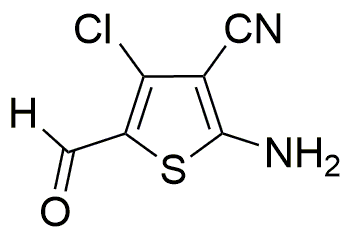2-Amino-4-chloro-5-formyl-3-thiophenecarbonitrile is widely utilized in research focused on:
- Pharmaceutical Development: This compound serves as an important intermediate in the synthesis of various pharmaceuticals, particularly those targeting anti-inflammatory and anti-cancer activities.
- Organic Synthesis: It is frequently employed in organic chemistry for the preparation of thiophene derivatives, which are valuable in the development of new materials and compounds.
- Biological Research: Researchers use this chemical to study its biological properties, contributing to the understanding of its potential therapeutic effects and mechanisms of action.
- Material Science: The compound is explored for its applications in creating conductive polymers and other advanced materials, enhancing the performance of electronic devices.
- Analytical Chemistry: It is utilized as a reagent in various analytical techniques, aiding in the detection and quantification of other chemical species in complex mixtures.
Informations générales
Propriétés
Sécurité et réglementation
Applications
2-Amino-4-chloro-5-formyl-3-thiophenecarbonitrile is widely utilized in research focused on:
- Pharmaceutical Development: This compound serves as an important intermediate in the synthesis of various pharmaceuticals, particularly those targeting anti-inflammatory and anti-cancer activities.
- Organic Synthesis: It is frequently employed in organic chemistry for the preparation of thiophene derivatives, which are valuable in the development of new materials and compounds.
- Biological Research: Researchers use this chemical to study its biological properties, contributing to the understanding of its potential therapeutic effects and mechanisms of action.
- Material Science: The compound is explored for its applications in creating conductive polymers and other advanced materials, enhancing the performance of electronic devices.
- Analytical Chemistry: It is utilized as a reagent in various analytical techniques, aiding in the detection and quantification of other chemical species in complex mixtures.
Documents
Fiches de données de sécurité (FDS)
La FDS fournit des informations de sécurité complètes sur la manipulation, le stockage et l’élimination du produit.
Spécifications du produit (PS)
Le PS fournit une description complète des propriétés du produit, notamment sa composition chimique, son état physique, sa pureté et les exigences de stockage. Il détaille également les plages de qualité acceptables et les applications prévues du produit.
Certificats d'analyse (COA)
Recherchez des certificats d'analyse (COA) en saisissant le numéro de lot du produit. Les numéros de lot et de lot se trouvent sur l'étiquette d'un produit, après les mots « Lot » ou « Lot de fabrication ».
Numéro de catalogue
Numéro de lot/série
Certificats d'origine (COO)
Ce certificat d'exploitation confirme le pays dans lequel le produit a été fabriqué, et détaille également les matériaux et composants utilisés et s'il est issu de sources naturelles, synthétiques ou autres sources spécifiques. Ce certificat peut être requis pour les douanes, le commerce et la conformité réglementaire.
Numéro de catalogue
Numéro de lot/série
Fiches de données de sécurité (FDS)
La FDS fournit des informations de sécurité complètes sur la manipulation, le stockage et l’élimination du produit.
DownloadSpécifications du produit (PS)
Le PS fournit une description complète des propriétés du produit, notamment sa composition chimique, son état physique, sa pureté et les exigences de stockage. Il détaille également les plages de qualité acceptables et les applications prévues du produit.
DownloadCertificats d'analyse (COA)
Recherchez des certificats d'analyse (COA) en saisissant le numéro de lot du produit. Les numéros de lot et de lot se trouvent sur l'étiquette d'un produit, après les mots « Lot » ou « Lot de fabrication ».
Numéro de catalogue
Numéro de lot/série
Certificats d'origine (COO)
Ce certificat d'exploitation confirme le pays dans lequel le produit a été fabriqué, et détaille également les matériaux et composants utilisés et s'il est issu de sources naturelles, synthétiques ou autres sources spécifiques. Ce certificat peut être requis pour les douanes, le commerce et la conformité réglementaire.


